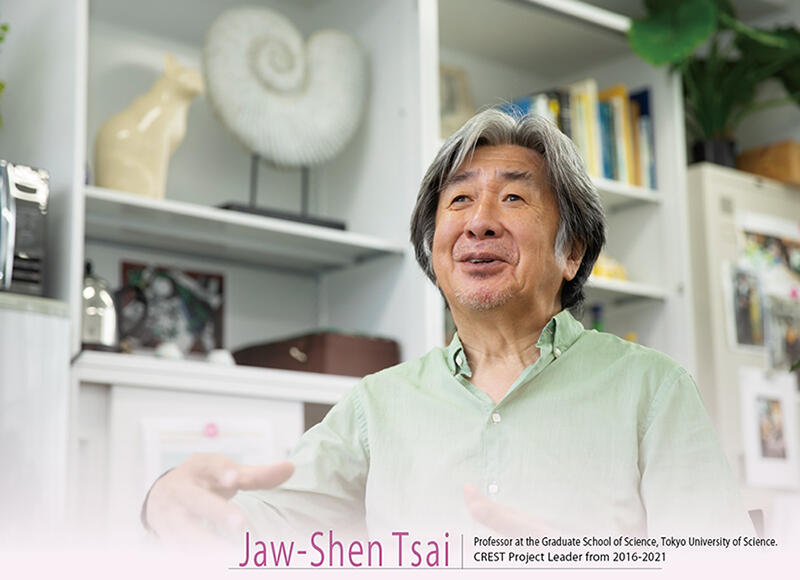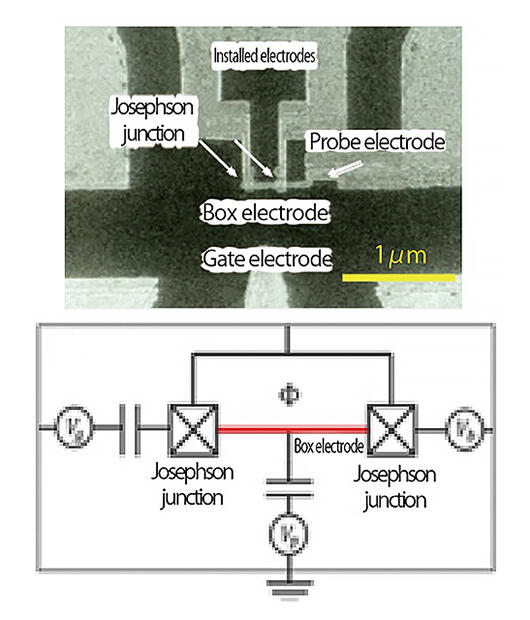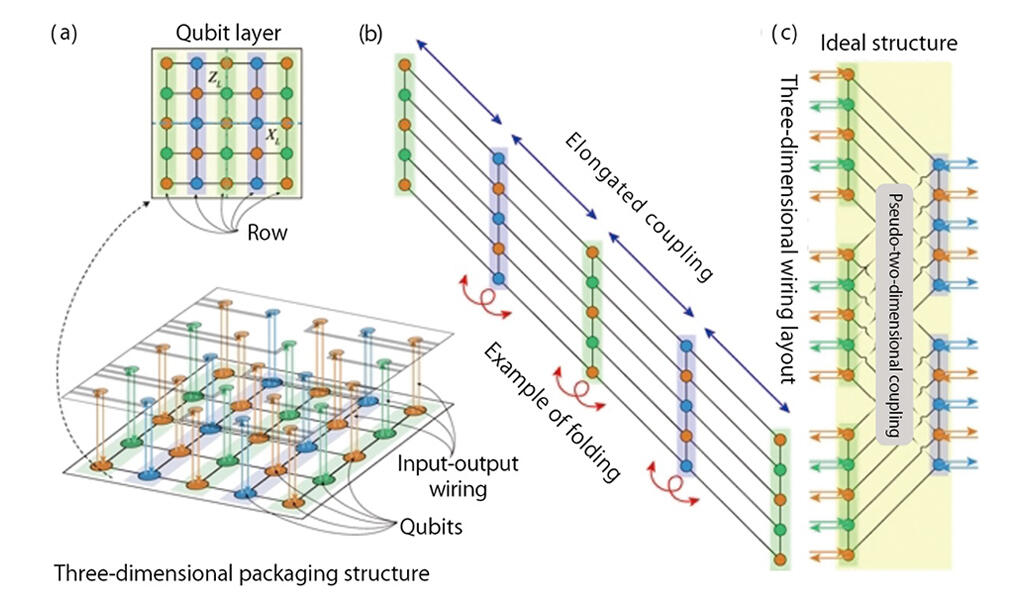Multiple techniques have been proposed for quantum computers, but the most advanced is the superconducting method. Much like the computers we use today, quantum computers require the integration of quantum bits (qubits), but the development of input-output wiring that is not affected by factors such as ambient temperature and magnetism has posed a significant challenge. Professor Jaw-Shen Tsai of the Graduate School of Science, Tokyo University of Science, has proposed a new circuit that is integrated by using an "origami" structure in which elements are arranged and wired on a flat surface that is then folded, making a significant contribution to the implementation of quantum chips.

World's first superconducting qubit experiment discovers the free flow of electrons
Quantum computers quickly gained attention after Google in the U.S. announced in 2019 that a supercomputer had solved a problem in 200 seconds that would normally have taken 10,000 years, but Jaw-Shen Tsai, a researcher at the Graduate School of Science, Tokyo University of Science, who leads the CREST project on "Photon based quantum information processing utilizing superconducting artificial atoms," explained the characteristics of quantum computers in the following manner. "Compared with the conventional computers we use today, a quantum computer has the advantages of a faster processing speed, the ability to derive multiple possibilities simultaneously and to handle a greater amount of information, and can solve far more complex problems."
This advantage has its origins in the way that information is handled. While a conventional computer processes information by setting the state as either a 0 or a 1, a quantum computer treats information as a "superposition of 0s and 1s." A conventional computer can only handle one piece of information at a time, whereas a quantum computer can handle several simultaneously, and can also perform parallel processing of calculations. Professor Tsai is one individual who is fascinated by the curious qualities of quantum mechanics.
His interest was piqued when he participated in the CREST project "Small Metallic Tunnel Junctions, Physics and Applications" (1996-2001), which studied the behavior of electrons when certain metals and other materials enter a state of superconductivity by being cooled to near absolute zero (-273.15 degrees Celsius), at which point there is no electrical resistance. Professor Tsai recalled that, "just like water dripping out of a faucet, when the diameter of the tunnel the electrons were flowing through was narrowed and individual electrons were going through one by one, the phenomenon of a quantum state occurred in which electrons would appear and disappear. I thought this was really interesting, and so I started to work on qubits."
Then, in 1999, together with Yasunobu Nakamura, who was working at NEC Corporation Laboratories at the time (currently a professor at the Research Center for Advanced Science and Technology, University of Tokyo), he succeeded in the world's first experiment with a superconducting qubit (Fig. 1). When two electrodes in a superconducting state are brought into close proximity, the electrons in the adjoining areas can flow freely between the two electrodes in a quantum state phenomenon called the "Josephson Effect." Furthermore, it was demonstrated that quantum states can be controlled and read by applying an external microwave pulse.
Fig. 1: Scanning electron micrograph (SEM) image and circuit diagram for the superconducting qubit developed in 1999

"Until that point, quantum behavior was used to describe the world of atoms and molecules, and it defied common sense for a large object like a metal electrode to behave in a quantum manner, so we called it a 'coherent macroscopic quantum state.'" As the superconducting qubits that Professor Tsai and his team developed are solid-state components that are easy to handle and easy to integrate, researchers around the world began aiming to develop a quantum computer based on superconducting circuits. The superconducting qubits at that time were unstable and the coherent time in which the quantum state was maintained was at the nano-second level (one-billionth of a second), but this has now been extended to nearly a millisecond, which stands up to practical use and led to Google's aforementioned achievement.
A new circuit is born from a change in thinking: Successfully demonstrated with 10 qubits
Currently, quantum computers are broadly divided into two camps. One uses the quantum annealing method, which specializes in combinatorial optimization problems, and the other is the quantum gate method, which solves problems by creating computational circuits in the same way as classical computers, using gate operations such as AND, OR, or NOT. The superconductivity method that Professor Tsai and his team are working on is one of the gate-based methods. Other methods include photon and ion traps that operate at room temperature. The annealing method has been put into commercial use first, but there are high expectations for practical applications of gate-based methods due to their superior versatility.
A major challenge for superconducting circuit systems is the integration of qubits. Quantum computers with superconducting circuits that have been developed until now have been limited to around 100 qubits. Considering that a CPU in a computer today has hundreds of millions of elements integrated on a single chip, the level of integration in quantum computers is still only in its early stages.
Moreover, a characteristic of qubits is that errors are likely to occur due to the influence of ambient temperature, magnetism, or other environmental factors. To this end, multiple qubits are linked together to work as a group, which allows errors to be corrected in the middle of calculating each time it happens. For this to happen, no less than 1,000 qubits need to be integrated in order to perform calculations with a high degree of accuracy. At this point, the issue becomes the wiring.
In a superconducting circuit, qubits are placed on a flat lattice, but wiring is necessary to send control signals to each qubit and to read the signals of the calculation results. If there are 100 qubits, they would be laid out in a 10x10 grid, so it should be possible to wire it in the vertical direction. However, 900 qubits would be arranged in a 30x30 grid, and 10,000 qubits would be 100x100, and the wiring must be considered. "It is simple enough to wire the qubits on the outer edges, but it gets more and more difficult to wire them as they get closer to the center of the grid, and errors are also more likely to occur because of all the wiring. So we changed our thinking, and came up with a new wiring technology," Professor Tsai said, explaining the problem and the approach they took to solve it.
Basically, the idea was to move all of the qubits to the outside of the circuit by folding the flat lattice like origami or a folding screen. (Fig. 2) Not only would this make the wiring easier, but it would also improve the reliability of logical qubits because inter-wire interference and losses would be reduced. The biggest hurdle was that folding caused wires that connected some of the qubits to get crossed, but Professor Tsai's team overcame this by applying a technique used in microwave devices, which is to cover the wiring with a localized three-dimensional structure.
Fig. 2: New circuit method for superconducting quantum computers

To demonstrate the new circuit system, the research team is actually building and verifying a 10-qubit superconducting circuit to confirm that it is sufficiently feasible using the current technology. Professor Tsai says that, "In theory, this wiring technology is possible for up to around 900 qubits, which is the number needed for high-fidelity error correction. And by linking multiple slots, with each slot containing 900 qubits, a superconducting quantum computer with 10,000 qubits or even a million qubits is possible."
Needless to say, the large-scale integration of superconducting qubits presents various challenges, not limited only to wiring. In order to solve these issues, it will be necessary to mobilize multiple cutting-edge technologies such as quantum mechanics, nanotechnology, cryogenic and microwave engineering, and low-noise measurement. With such collaboration with other fields in mind, Professor Tsai is moving forward with his research to overcome the next challenge.
(Text: Shinji Moribe, photo: Hideki Ishihara)




